Mirella Sichirollo Patzer's Blog, page 20
November 13, 2014
The Scandal that haunted and ostracized poor Effie Gray

Effie Gray
Effie Gray was a great beauty. She was born in Scotland, and was raised in the same house where her grandfather committed suicide. Her parents encouraged a marriage with John Ruskin, the son of their long-time friends.

John Ruskin
But on their wedding night, something went drastically wrong and Ruskin never consummated the marriage? Why? Well, no one knows for certain, but it is rumored because Ruskin was repelled by his young wife’s body, her pubic hair, her menstrual blood. In a letter to her father, Effie wrote:
"He alleged various reasons, hatred to children, religious motives, a desire to preserve my beauty, and, finally this last year he told me his true reason...that he had imagined women were quite different to what he saw I was, and that the reason he did not make me his Wife was because he was disgusted with my person…."
It is no wonder that with such a horrible start to their marriage, it was doomed to deteriorate. Years passed, and Ruskin still had not touched his beautiful wife.
The couple travelled to Venice where Ruskin was researching a novel he would entitle The Stones of Venice. While Ruskin delved deep into his studies, Effie enjoyed herself and socialized. It was there she met a handsome Lieutenant named Charles Paulizza and a friendship soon blossomed between them. Ruskin even encouraged it, hoping an affair would give him cause to rid himself of her and the marriage they were both trapped in.
When Ruskin and Effie returned to Scotland, she modeled for her husband’s protégé, a Pre-Raphaelite artist named John Everett Millais.

John Everett Millais
Love soon bloomed and when they returned to London, Effie left Ruskin and returned to Scotland and stayed with her family. She wrote a note to Ruskin, enclosed her wedding ring, and told him she was going to seek an annulment. They had been married for 5 years, and she was still a virgin.
Of course, the court case set tongues a wagging. The annulment was granted and a year later, Effie married John Millais. She bore him eight children, in between acting as a model for her husband who depicted her as an icon of beauty and fertility.
In the meantime, John Ruskin sought to remarry a teenage girl named Rose La Touche.

Rose LaTouche
However, because of the scandalous allegations in his previous marriage to Effie, Rose’s parents were so concerned, they wrote Effie a letter seeking more details. Effie did not hold back. She described Ruskin as a oppressive husband, and the engagement was called off.
Effie was her new husband’s greatest fan. She supported him in his work, managed his career, raised her children, ran the home, and maintained a very busy social schedule despite the fact that her scandalous annulment from Ruskin excluded her from many social functions. She was banned from being in the presence of Queen Victoria. Being ostracized socially bothered Effie and her husband. Years later, as Millais lay dying, through the Queen’s daughter, he begged the Queen to allow Effie to attend official functions.

Little more than a year after Millais died, Effie also passed away.
For a comprehensive, fictionalized account of Effie's life and famous husbands, Duckworth Publishers presents:
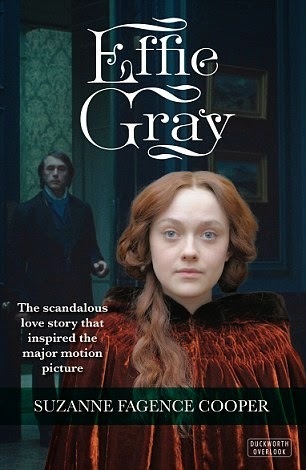
The Scottish beauty Effie Gray is the heroine of a great Victorian love story. Married at 19 to John Ruskin, she found herself trapped in an unconsummated union. She would fall in love with her husband's protege, John Everett Millais, and inspire some of his most memorable art, but controversy and tragedy continued to stalk her. Suzanne Fagence Cooper has gained exclusive access to Effie's family letters and diaries to show the rise and fall of the Pre-Raphaelite circle from a new perspective, through the eyes of a woman whose charm and ambition helped to shape the careers of both her husbands. Effie Gray is a compelling portrait of the extraordinary woman behind some of the greatest paintings of the Victorian era.
In the novel, The Passionate Lives of Effie Gray, author Suzanne Fagence Cooper takes us into Victorian England, Venice, Italy, Scotland, and into the heart of the scandal that haunted poor Effie her entire life.
Based upon a treasure of preserved letters, Cooper has recreated Effie’s life in great detail. The book is a comprehensive commentary on the life of this fascinating young woman who had been so shamed and berated because of her first husband’s neglect. I liked the fact that three possible reasons came to light regarding Ruskin’s strange behavior towards his beautiful wife. And I found the plight of Effie’s sister, Sophy, regarding her mental madness and anorexia very interesting.
Numerous photographs are included in the novel. My only disappointment was in the physical paperback version I was provided, the typesetting and fonts were so incredibly tiny, it made reading extremely fatiguing and trying. This knocked me out of the story. As I received an advance reading copy, I hope that the publisher has rectified this problem. Or I recommend purchasing the book in e-book format avoid eye strain.
This was a terrific story and definitely worth reading. It is so good it has been made into a movie, which only adds to my belief that this is definitely a book worth reading. An incredibly fascinating tale about a very courageous woman!









November 11, 2014
The Scandalous Secrets of Dorothy Richardson
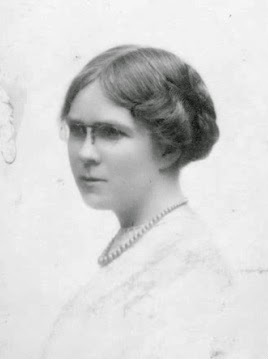
AuthorDorothy Richardson
Some people are born under an unlucky star, and this can be said about author Dorothy Richardson. She was born in Abingdon England in 1873 and by the time she was ten years old, her family moved to London. Her father began to experience a financial crisis, so Dorothy was forced to find work as a governess and then a teacher. Family troubles pulled her away from her independent life and she was forced to quit her job and return home to care for her deeply depressed mother. Despite Dorothy's efforts, her mother committed suicide and her father had to declare bankruptcy.
Dorothy found work as a secretary in a dental office. She began to hang out with writers and radicals, and that is when she met H.G. Wells, aka Bertie. Wells had married Jane, one of Dorothy's school chums.

"Bertie"H.G. Wells
As hard as she tried to ignore him, a strong sexual attraction with Bertie resulted in their having an affair which ultimately led to Dorothy becoming pregnant. The pregnancy resulted in a miscarriage.
 During this turbulent time, guilt ridden over cheating with her best friend's husband, Dorothy met and married Veronica Leslie-Jones, who was also having an affair with a married man. This united the two friends and they soon fell into a lesbian affair. Their affair lasted only as long as Veronica to meet Ben Grad, a good friend of Dorothy's. The two fell in love and married, though rumors abounded that they both loved Dorothy more than they loved each other.
During this turbulent time, guilt ridden over cheating with her best friend's husband, Dorothy met and married Veronica Leslie-Jones, who was also having an affair with a married man. This united the two friends and they soon fell into a lesbian affair. Their affair lasted only as long as Veronica to meet Ben Grad, a good friend of Dorothy's. The two fell in love and married, though rumors abounded that they both loved Dorothy more than they loved each other. Dorothy found solace in writing, and published her first novel, Pointed Roofs. She later started working as a freelance journalist and published two book about the Quakers.
With her two scandalous relationships behind her, she met a tall lanky artist named Alan Odle. He was fifteen years younger than she was.

They married and she supported her husband. They were content together, but sadly Odle died in 1948.

Alone, Dorothy moved into a nursing home in 1954. Three years later, she died.
Although her work never made her rich. Her entire life, she struggled to scrape out a living, to make ends meet. And although she never gained the respect she deserved as a writer, today Dorothy is considered an important feminist writer. Her work lives on because of its focus on female issues.
Richardson remains the most forgotten of the early and innovative practitioners of the stream-of-consciousness method of writing.
Dorothy Richardson's fascinating life is recreated in The Lodger, a novel by Louisa Treger.

Back Cover Blurb
Dorothy Richardson is existing just above the poverty line, doing secretarial work at a dentist's office and living in a seedy boarding house in Bloomsbury, when she is invited to spend the weekend with a childhood friend. Jane has recently married a writer who is hovering on the brink of fame. His name is H.G. Wells, or Bertie, as they call him.
Bertie appears unremarkable at first. But then Dorothy notices his grey-blue eyes taking her in, openly signaling approval. He tells her he and Jane have an agreement which allows them the freedom to take lovers, although Dorothy can tell her friend would not be happy with that arrangement.
Not wanting to betray Jane, yet unable to draw back, Dorothy free-falls into an affair with Bertie. Then a new boarder arrives at the house—beautiful Veronica Leslie-Jones—and Dorothy finds herself caught between Veronica and Bertie. Amidst the personal dramas and wreckage of a militant suffragette march, Dorothy finds her voice as a writer.
Louisa Treger's The Lodger is a beautifully intimate novel that is at once an introduction to one of the most important writers of the 20th century and a compelling story of one woman tormented by unconventional desires.
ReviewbyMirella Patzer
Dorothy's life is full of trials and tribulations, and author Louisa Treger successfully recreates it in this fresh and evocative story. From the stringent societal norms of the Victorian era, to the passion of the suffragette movement, to the first World War, Dorothy's life grows ever more challenging. This powerful tale is about how Dorothy found her own identity and voice in a time where women were of little notice or importance.
I enjoyed the secret love affairs Dorothy entered into, and how she paid an awful price for having gone through them. The scenes about the seedier side of London were also sleekly well written about. More importantly, when one reads between the storylines, we are exposed to the trials of women alone in the world during the Victorian era, and how courage, perseverence, and fear ruled their daily lives in order women to survive. And the author gives us beautiful insight into all such details. I highly recommend this biographical novel to all readers and writers interested in women's history.









November 7, 2014
Promote your biographical novel on History and Women
 Have you written or published a novel about a real woman of history? If so, there is no better place to promote it than the highly successful website, HistoryandWomen.com.
Have you written or published a novel about a real woman of history? If so, there is no better place to promote it than the highly successful website, HistoryandWomen.com.With over 1.7 million total visitors, over 36,000 views per month, and over 1,100 views per day, History and Women helps get the word out about your book.
For $25 USD, if you provide us with your book cover, back cover blurb, book trailer, first chapter, author photo, author bio, and a brief bio about the historical woman your book is about, I will run the promotion for 7 days. It will include a daily Tweet and Facebook post.
If you are interested, please contact me at:
historyandwomen@gmail.com









November 6, 2014
Jack the Ripper had a knife! He gutted five women, except for his wife!

Florence Elizabeth Chandler was born to a family of good means in Mobile Alabama. Her father was the mayor and a partner in a successful banking firm. After her father died, her mother, Caroline Chandler Du Barry remarried. Florence accompanied her mother on a ship to Britain, and it was there she met James Maybrick, a very successful cotton broker, who came from a good family. She was 19, he was 42, and despite the vast age difference, they fell in love. A marriage ceremony in Piccadilly soon followed. The couple soon settled in London, dancing and dining, popular within the highest social circles. They were the picture of happiness! But in private, their lives were anything but!

Studio Photo of Florence Maybrick
Poor Florence soon discovered that James was an addict of arsenic and other poisonous concoctions.

Note that there is strychnine and arsenic in the ingredients
Men like James Maybrick took such tonics or elixirs to improve manhood / sexual issues
And if that weren’t enough, she learned that he had numerous affairs, one of which was a long lasting one in which he had five illegitimate children. To make matters worse, James regularly beat her, often quite severely.
Miserable, Florence went in search of finding a corner of peace and joy for herself. She too began having affairs. Both struck close to home – Edwin Maybrick, James’ brother, and Alfred Brierley, James’ colleague. Of course, the inevitable happened and James learned about her affair with Brierley. He beat her nearly to death and threatened her with divorce.
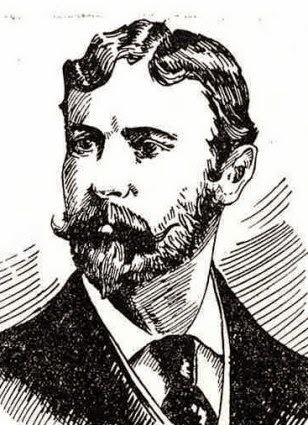 Alfred Brierley
Alfred BrierleyEarly in April 1889, Florence traipsed down to her neighborhood chemist to buy some flypaper laced with arsenic. She soaked it in a bowl of water, claiming it was her way to extract the arsenic for a cosmetic lotion she wanted to prepare. She had run out of the actual lotion and was trying to create her own similar recipe.

Meanwhile, on the 27th day of April, James took a double dose of strychnine.

That made him severely ill. Doctors were called and they treated him for severe indigestion, but without satisfactory results. His condition grew steadily worse.
In May, Florence wrote a letter to Brierly, but somehow, the nanny, who had never been fond of her mistress intercepted it and handed it to Edwin – her husband’s brother with whom she had slept with a time or two. Edwin handed the letter over to Michael Maybrick, the eldest brother. Michael's stripped Florence of her household duties and kept her under scrutiny, forbidding her to leave the house.
But Florence’s troubles were far from over. Early in May, one of the nurses in attendance to her husband reported that Florence had tampered with a meat-juice bottle in her husband’s room. James never drank any of it. Nevertheless, the contents of the bottle were analyzed and a half-grain of arsenic was identified. James Maybrick died at his home on May 11th.
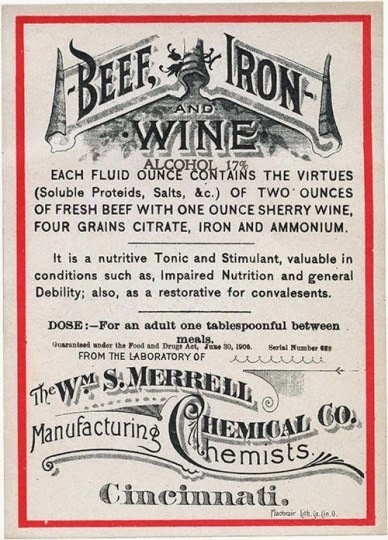
Suspicious as to the cause of his death, or perhaps to get rid of Florence once and for all, had his body examined. Traces of arsenic were found, but not in amounts that would be considered lethal. Despite the fact that no one could prove who administered it, whether it was James or someone else, an inquest was held and Florence was formally charged with the murder of her husband.

Courtroom where Florence's trial was heldSt. George's HallLiverpool, England
In a trial that today might be considered prejudiced and biased, she was found guilty and sentenced to death.
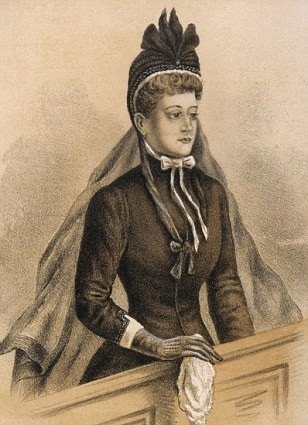
Florence Maybrick in the prisoner's box in court
The London public was highly divided over this case. Many supported Florence, believing in her innocence, while others were adamant as to her guilt. Fifteen years passed. Florence spent her time in jail, awaiting her death, longing for her children who were adopted out to a doctor and his well-to-do family.
The evidence was re-examined and the Chancellor concluded:
“…that the evidence clearly establishes that Mrs Maybrick administered poison to her husband with intent to murder; but that there is ground for reasonable doubt whether the arsenic so administered was in fact the cause of his death”.

Florence’s death sentence to hang was commuted to life imprisonment.
To say Florence’s case was sensational would be an understatement. It made headlines in Britain as well as North America. Many men used arsenic as an aphrodisiac, and it was clear that James had been a devoted user.

What finally helped sway the scales of justice in her favor was when a city chemist testified he had supplied James Maybrick with a steady flow of the arsenic over many years. A search of the home had previously revealed enough arsenic to kill fifty people or more.
After leaving prison, Florence returned to the U.S., writing a biography entitled My Fifteen Lost Years and toured about the country giving lectures protesting her innocence.


Lecture Tour Brochure
As the years passed, she became a recluse, a cat lady, and lived under an assumed name. No one knew who she truly was. She died alone and penniless on October 23, 1941.

Among her possessions was a tattered family bible. Pressed between its pages was a scrap of paper, which, in faded ink bore the recipe for the soaking of flypapers for use as a beauty treatment.
But Florence’s story is far from over. 51 years after her death, in 1992, James Maybrick’s diary surfaced. In it, Maybrick confessed to being Jack the Ripper. The problem was that in its written pages, James Maybrick never mentioned his name. His connection to the diary was made through is written references that corresponded with Maybrick's life and behaviors and occurrences. The author of the diary wrote about his crimes over a period of several months, taking credit for killing the five women credited to Jack the Ripper as well as two other murders which to this day have not been identified.
As well as the diary, a pocket watch surfaced in 1993. Engraved on the inside were the words “I am Jack” and the initial of 5 murdered women.

Although the watch and diary provide convincing evidence, neither Jack Maybrick, his diary, nor his pocket watch, can be clearly linked to Jack the Ripper and his personal items.

Diary Page signed by Jack the Ripper
For a wonderful fact based fictionalized story about Florence and James and their sordid relationship, I urge you to read The Ripper’s Wife by Brandy Purdy! She truly brings all the facts of this tale to vibrant life.
Please join Brandy Purdy and HF Virtual Book Tours for The Ripper's Wife Blog Tour from October 27-November 14.

Publication Date: October 27, 2014 | Kensington Books | Formats: eBook, Paperback
Genre: Historical Fiction


Back Cover Blurb
A suspenseful, spellbinding novel of love, jealousy, and murder, The Ripper's Wife re-imagines the most notorious serial killer in history through the eyes of the woman who sealed his fate.
"Love makes sane men mad and can turn a gentle man into a fiend."
It begins as a fairytale romance--a shipboard meeting in 1880 between vivacious Southern belle Florence Chandler and handsome English cotton broker James Maybrick. Courtship and a lavish wedding soon follow, and the couple settles into an affluent Liverpool suburb.
From the first, their marriage is doomed by lies. Florie, hardly the heiress her scheming mother portrayed, is treated as an outsider by fashionable English society. James's secrets are infinitely darker--he has a mistress, an arsenic addiction, and a vicious temper. But Florie has no inkling of her husband's depravity until she discovers his diary--and in it, a litany of bloody deeds...
ReviewbyMirella Patzer
The Ripper’s Wife, a most definite page turner, is a richly written, dark, novel about the life of Florence Maybrick, the wife of a man suspected of being Jack the Ripper. The story closely follows the actual circumstances of their lives and the sensational trial that followed. The pages are decorated with brilliant and detailed descriptions of fashion, architecture, and home décor of the Victorian era. Told in the first person narrative of Florence Maybrick, author Brandy Purdy delves deep into the mind and thoughts of this young wife whose marriage slowly falls apart because of addictions, affairs, rage, cannibalism, and violence.
This book is not for the feint of heart. The murder of the five prostitute victims of Jack the Ripper are graphically described, as is the deranged mind of the killer. No book can be darker, so be forewarned. Should you have the fortitude and courage to venture forward and read this lush tale, you will find it beautifully written, strongly told, and bold in every way. Having read all of Brandy Purdy’s books, I have to say this is the very best she has produced. Definitely very, very highly recommended.
Praise for the Novels of Brandy Purdy
"Recommended for readers who can't get enough of the Tudors and have devoured all of Philippa Gregory's books." —Library Journal on The Boleyn Wife
"Purdy wonderfully reimagines the behind-the-scenes lives of the two sisters." —Historical Novel Reviews on The Tudor Throne
"I love Brandy Purdy's books, she does thorough research into the lives of the people in the Tudor era and it shows in her writing style. Very descriptive, engaging characters makes The Queen's Rivals a page turning novel. If you are a fan of the Tudor era like I am, then this book is a must." -CelticLady's Reviews on The Queen's Rivals
"The writing is inviting, intense and flawless, rich with the flavor of English country life as well as court life. The political machinations, the tragedy to befall the Dudley family and the mystery surrounding Amy's death were weaved to captivating detail and the end result is a mesmerizing work of historical fiction that puts Brandy Purdy on my "must read" list." -Psychotic State Book Reviews on The Queen's Pleasures.
Buy the Book
Amazon UKAmazon USBarnes & NobleBook Depository
About the Author
Brandy Purdy is the author of several historical novels. When she's not writing, she's either reading or watching classic movies. She currently lives in Beaumont, TX. Visit her website at http://www.brandypurdy.com for more information about her books. You can also follow her via her blog at http://brandypurdy.blogspot.com/ where she posts updates about her work and reviews of what she has been reading.
The Ripper's Wife Blog Tour Schedule
Monday, October 27Review at A Bookish Affair
Tuesday, October 28Review & Giveaway at Historical Fiction ObsessionInterview & Giveaway at A Bookish Affair
Wednesday, October 29Review at Kinx's Book NookReview at The Maiden's Court
Thursday, October 30Review at Book of Secrets
Friday, October 31Review at WTF Are You Reading?Feature at Passages to the Past
Monday, November 3Review at A Chick Who ReadsInterview & Giveaway at Mina's Bookshelf
Tuesday, November 4Review at 100 Pages a Day - Stephanie's Book reviewsInterview at A Chick Who Reads
Wednesday, November 5Review at JulzReads
Thursday, November 6Review at History & Women
Friday, November 7Review at A Book Geek
Monday, November 10Review at CelticLady's Reviews
Tuesday, November 11Review & Giveaway at Historical Tapestry
Wednesday, November 12Review & Giveaway at Broken Teepee
Thursday, November 13Review at A Bibliotaph's Reviews
Friday, November 14Review at Girl Lost in a Book








October 27, 2014
Spare the Rod - Spoil the Wife

Did you know that it wasn’t until recent history, the 20th century, that it became unlawful for husbands to beat their wives? Domestic violence has been a harsh reality for women for thousands of years. In my latest novel, The Novice, the underlying theme is domestic violence. I wanted to demonstrate the cycle of violence. If a woman in medieval times could free herself from the cycle of abuse, today’s women can choose to do the same. What follows is a historical timeline of domestic violence through the centuries.
735 B.C.
In Rome, the Law of Chastisement came into effect. Because a husband was liable for his wife’s actions, this law gave husbands the absolute rights to physically discipline their women provided that he beat her with a rod or switch no greater than the girth of the base of the man’s right thumb. This rule became a guideline for more than a thousand years.

300 A.D.
The Church affirms a husband's authority to discipline a wife. Holy Roman Emperor, Constantine the Great, has his wife burned alive when she was no longer of use to him.
900 to 1300 A.D.
In medieval Europe, the Church sanctions wife beatings. Priests advise abused wives to win their husbands' good will through increased devotion and obedience. Women are viewed as a lesser species, without the same feelings and capacity for suffering than men.

1400 A.D.
A Friar in Siena writes Rules of Marriage, religious laws that support wife-beating.
A woman named Christine de Pizan accuses men of cruelty and beating their wives. She begins the fight for women’s basic humanity, better education, and fair treatment in marriages.
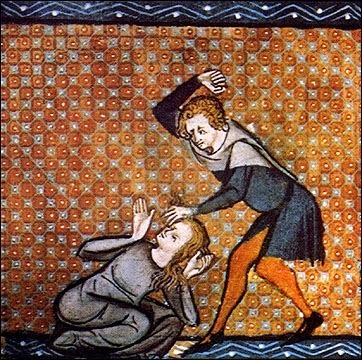
1427 A.D.
Saint Bernardino of Siena asks his male parishioners to restrain themselves when disciplining their wives and to show them the same mercy they would show their hens and pigs.
1500 A.D.
In England, Lord Hale, a woman hater who regularly burned women at the stake as witches condones marital rape. Apparently, a husband cannot be guilty of rape because marriage was a contract and when a wife gave herself to a husband, she could not retract her consent.
Early settlers in America permit wife-beating for correctional purposes, however there is growing movement to declare wife-beating illegal.
In Russia, the Church sanctions the oppression of women by issuing an ordinance that made it legal for a man to beat or kill his wife for disciplinary purposes. But if a Russian woman killed her husband for injustices, the penalty was for her to be buried alive with only her head above the ground, and left to die.
In England, women and children are taught that it was their duty to obey the man of the house. Violence was encouraged.
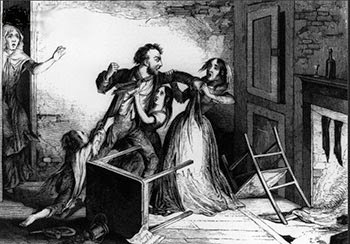
1700 A.D.
In Germany, two lesbians were placed on trial for lesbianism and domestic violence. Both women were found guilty. One was sentenced to death. The other was sent to jail for 3 years and then banished, not because she was the victim of the violence, but because she was simple-minded.

1800 A.D.
England abolishes the right for men to chastise women.
Sweden gives men and women equal inheritance rights.
The American Society for the Prevention of Cruelty to Animals and the Society for the Prevention of Cruelty to Children are founded long before any organization to prevent cruelty to women.
A man in North Carolina was charged with striking his wife with a switch about the size of one of his fingers, but smaller than his thumb. The court upheld his acquittal on the grounds that no court should interfere with family government in trifling cases.
General Sherman, when he was negotiating the Treaty of 1868 with the Navajos insisted that the Navajos select male leaders only. The rule stripped Navajo women of their ability to participate in decision-making and taught Navajo men that it was okay to rob women of economic and political power, and to beat them.
Francis Power Cobbe published Wife Torture in England. In it, she documented 6,000 of the most brutal assaults on women over a 3 year period who had been maimed, blinded, trampled, burned and murdered. She believed that abuse by men continued because of the belief that a man's wife was his property. Her concerns resulted in a new law that allowed victims of violence to obtain a legal separation from the husband; entitled them custody of the children; and to retain earnings and property secured during the separation. But only if the husband was convicted of aggravated assault and the court determined she was in grave danger.
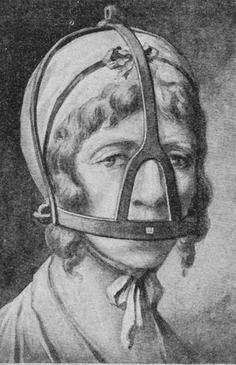
In England, the law was changed to permit a wife who had been habitually beaten by her husband to the point of life endangerment to separate from him, but not to divorce him
During the reign of Queen Victoria, new laws came into effect whereby wives could no longer be kept under lock and key, life-threatening beatings were considered grounds for divorce, and wives and daughters could no longer be sold into prostitution.

1900 A.D.
A French court rules that husbands have no right to beat their wives. Prior to this, the Napoleonic Code decreed that, “Women, like walnut trees, should be beaten every day.”










October 26, 2014
Anita Delgado - The Spanish Dancer who became an Indian Princess

Anita Delgado
Who doesn’t love a real life fairy tale come true? Anita Delgado was a very beautiful dancer from Spain. Her father struggled to provide for his family, so Anita and her sister danced to help her family. It was while she was dancing that a Maharaja by the name of Jagatjit Singh Bhadur of Kapurthala was in the audience and became mesmerized by her performance.

Maharaja Jagatjit Singh Bhadur of Kapurthala
He sent her notes and gifts pleading for her to meet with him, but the virtuous Anita refused them all. Even after he returned to his homeland, the letters continued, and soon, Anita was persuaded to answer them. He proposed to her, offering her family enough money to take care of them for life. At first, Anita hesitated because the Maharaja had other wives, but he assured her with promises they could be married in Europe and that she would have a home of her own in his homeland. These promises he made, create controversy for him. His government and family advise against the marriage, but he follows his heart. After they marry, Anita becomes pregnant and is brought to Kapurthala where she must face not only the animosity from his wives, but the government refuses to recognize her and she struggles to assimilate into a culture very foreign from her own.
What follows is a tale of great love, of immense wealth, but profound loneliness. With her gentle personality, kindness, and patience, she wins the heart of the people of Kapurthala who are fascinated with her, as well as the media of the time.
Their story is immortalized by author Javier Moro in a sumptuously exotic novel ripe with the visions and aromas of India!
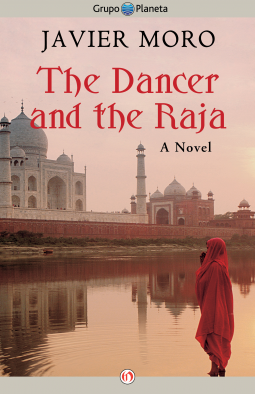
A fascinating novel that transports us to the fabulous world of the maharajas— abundant with harems, bacchanalian orgies, jewels, palaces, flamenco music, horses, Rolls-Royces, and tiger hunting.
On January 28, 1908, a young Spanish woman sitting astride a luxuriously bejeweled elephant enters a small city in northern India. The streets are packed with curious locals who are anxious to pay homage to their new princess, with skin as white as the snows of the Himalayas.
This is the beginning of the story, based on real events, of the wedding of Anita Delgado and the maharaja of Kapurthala, a grand story of love and betrayal that took place over almost two decades, in the heart of an India that was on the verge of disappearing.









October 7, 2014
The Tantalizing, Wonderous, Engimatic tale of the Queen of Sheba and her love affair with King Solomon
The following video in three parts about King Solomon and the Queen of Sheba are worth watching if you have about 40 minutes or so. So kick back, grab yourself a nice tea, and enjoy this mesmerizing story of two greatest personages in history and the great temporary love they once shared. Definitely the stuff that dreams are made of. This fascinating love story is told in the new novel, The Legend of Sheba by Tosca Lee

Back Cover Blurb
Her name is legend. Her story, the epic of nations. The Queen of Sheba. A powerful new novel of love, power, and the questions at the heart of existence by the author of the award-winning “brilliant” (Library Journal) and “masterful” (Publishers Weekly) Iscariot.
There is the story you know: A foreign queen, journeying north with a caravan of riches to pay tribute to a king favored by the One God. The tale of a queen conquered by a king and god both before returning to her own land laden with gifts.
That is the tale you were meant to believe.
Which means most of it is a lie.
The truth is far more than even the storytellers could conjure. The riches more priceless. The secrets more corrosive. The love and betrayal more passionate and devastating.
Across the Red Sea, the pillars of the great oval temple once bore my name: Bilqis, Daughter of the Moon. Here, to the west, the porticoes knew another: Makeda, Woman of Fire. To the Israelites, I was queen of the spice lands, which they called Sheba.
In the tenth century BC, the new Queen of Sheba has inherited her father’s throne and all its riches at great personal cost. Her realm stretches west across the Red Sea into land wealthy in gold, frankincense, and spices. But now new alliances to the North threaten the trade routes that are the lifeblood of her nation. Solomon, the brash new king of Israel famous for his wealth and wisdom, will not be denied the tribute of the world—or of Sheba’s queen. With tensions ready to erupt within her own borders and the future of her nation at stake, the one woman who can match wits with Solomon undertakes the journey of a lifetime in a daring bid to test and win the king. But neither ruler has anticipated the clash of agendas, gods, and passion that threatens to ignite—and ruin—them both. An explosive retelling of the legendary king and queen and the nations that shaped history.
ReviewbyMirella Patzer
The legend of the Queen of Sheba has captured the imaginations of people for many centuries. Now, in a newly written, lushly described novel, author Tosca Lee brings this fascinating, enigmatic woman to life. It is the 10th century B.C. and a young woman with three names, Bilqis, Sheba, Makeda, has inherited her father’s throne. Through a traveling merchant, she learns about King Solomon of Israel. Soon she exchanges letters with this distant king, who piques her interest and fills her with wonder. So in a bold move, against the wishes of her advisors, she compiles a vast hoard of riches and treasures and arranges for a caravan to make a near impossible and treacherous trek to visit him. What follows is a wonderful tale of passion and intrigue.
This novel excelled at breathing life into the Biblical characters of Solomon and Sheba. Rich, quippy, intelligent dialogue are exchanged between these two monarchs, luxuriant with hidden meanings, and ripe with hidden love. An comfortable read, brilliant descriptions, and a story line with plenty of peril and intrigue makes this new novel definitely one to savor. I thoroughly enjoyed it and definitely recommend it!









September 28, 2014
The Novice: A Love Story by Mirella Sichirollo Patzer Book Tour!
The Novice: A Love Story
Historical Fiction Virtual book Tour!
Below are the dates and blogs to visit.Come see read the first reviews, learn more about me through questions and answers, and enter to win free copies of the book!

 The Novice Blog Tour ScheduleMonday, September 29Review at Flashlight CommentarySpotlight and Giveaway at Passages to the Past
The Novice Blog Tour ScheduleMonday, September 29Review at Flashlight CommentarySpotlight and Giveaway at Passages to the PastTuesday, September 30Review and Giveaway at Peeking Between the PagesInterview at Triclinium – Elisabeth Storrs
Wednesday, October 1Guest Post at Book BabeSpotlight at Historical Fiction Obsession
Thursday, October 2Review and Giveaway at The Book Binder’s DaughterInterview and Giveaway at Historical Romance Lover
Friday, October 3Spotlight and Giveaway at Historical Fiction Connection
Monday, October 6Review at History From a Woman’s Perspective
Tuesday, October 7Review at Unshelfish
Wednesday, October 8Guest Post and Giveaway at Historical Tapestry
Thursday, October 9Spotlight at CelticLady’s Reviews
Friday, October 10Review at With Her Nose Stuck in a BookGuest Post at Keely Brooke Keith









September 26, 2014
Hoyden of the Week - Drive In Gal!
September 25, 2014
The bizarre tale of Marie Antoinette and the ostentatious diamond necklace
 Actual Replica of Necklace
Actual Replica of Necklace
Madame du BarryThe intended recipient of the necklace
Madame du Barry, mistress to King Louis XV, never imagined she would be the recipient of one the grandest, infamous diamond necklaces in the history of the world. Weighing in at 2,800 carats, the jewelers thought they'd fetch 1.6 million livres for the stunner, roughly equivalent to 100 million U.S. dollars in today's market.

King Louis XV
The king spent a fortune to commission the ostentatious jewel, but before he could present it to her, he died of smallpox. His death sent the royal court into a tailspin and Madame du Barry found herself evicted from the palace with barely the clothes on her back. What was the heir to the throne, Louis XVI to do with such a flamboyant bauble when the jewelers held out their hand for payment?

King Louis XVI
He offered it to his wife, Marie Antoinette, of course. Can you imagine his surprise when his fashionistawife refused to accept his gift? Her excuse was that the money would be better spent buying a war ship, but in reality, it was rumored she did not want to wear a necklace created for a woman she had detested!

Marie Antoinette
So the jewelers tried to peddle the necklace to other royals outside of France, but no one seemed interested in purchasing the expensive trinket. They made one last attempt to sell it to the king or Marie Antoinette after she gave birth to an heir, but she refused it again.Enter Jeanne de Saint-Remy de Valois! A con artist, an opportunist, a descendant of a previous king’s bastard. She would find a way to use the necklace as a means to get out of debt and rise in influence and status.

Jeanne de Saint-Remy de Valois
This shouldn’t be too hard to do since she was the mistress of Cardinal de Rohan, a man of great power who aspired to even greater heights than his illustrious robes would provide.

Cardinal de Rohan
Unfortunately, the good cardinal was not in Queen Marie Antoinette’s good graces. In fact, she detested the man because he had spread rumors about Marie Antoinette and had made offensive comments about her mother, Austrian empress Maria Theresa.
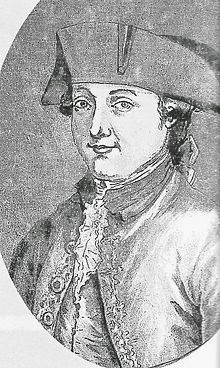
Retaux de Villette
Rohan began corresponding to the queen, and Jeanne delivered the warmhearted replies she swore were written by the queen, but were really written by her new lover, Retaux, an excellent forger. Soon, the letters became very, very warm, enough to convince the Cardinal that Marie Antoinette was falling in love with him. Thus, he became smitten. Jeanne arranged a secret tryst for the Queen and the Cardinal under the darkness of night in the gardens behind the Palace of Versailles.The Cardinal may have believed he was meeting with the queen, but in fact, he was meeting with a prostitute who resembled Marie Antoinette hired by Jeanne. The faux queen, Nicole Lequay d'Oliva, accepted the Cardinal’s rose and promised to forgive his transgressions against her.
 ProstituteNicole Lequay d'OlivaTo maintain the illusion, Jeanne asked for large sums of money from the Cardinal, convincing him it was for the queen’s charities. Eager to impress the Queen, the cardinal eagerly handed over the money to Jeanne. Of course there were no charities. Rather, Jeanne used the cash to climb the social, made easier because she openly bragged about being the Queen’s friend. And everyone believed her.Meanwhile, the jewelers were still trying to sell Marie Antoinette the necklace. Apparently, the "Queen" sent several letters to the cardinal ordering him to purchase the jewel on her behalf. The letter was signed Marie Antoinette de France. Poor Cardinal Rohan, he had no idea that French queens did not sign their letters that way. Jeanne convinced the Cardinal that Marie Antoinette wanted the necklace, and wanted him to buy it for her, but was afraid to buy it herself when the people of France were so disenchanted with the nobility. Cardinal Rohan met with the jewelers, presented them with the queen’s letter detailing the conditions of the purchase, and bought the jewel for 2,000,000 livres, to be paid in installments. He brought the necklace to Jeanne's house, where a man, whom Rohan believed to be the queen’s valet, came to fetch it. The valet was no valet. He was Retaux and he quickly hurried to London, had it broken up in pieces, and sold the diamonds individually.The jewelers were waiting for payment, but the Cardinal didn't have the funds to make the first payment. The jeweler went straight to the king and queen to collect his money. Marie Antoinette told him she never ordered nor received the necklace. The jeweler explained all the details to her. The king was furious.The King and Queen ordered the Cardinal brought before them. He produced the Queen’s letter. When the King read it, he became furious at the Cardinal for having been fooled by the fake signature. He had the cardinal arrested and thrown into the Bastille. On the way to the infamous jail, the cardinal sent home a note ordering the destruction of all his correspondence. It took the King three days to identify Jeanne as a partner in crime. That gave her plenty of time to destroy all the evidence she had in her possession. The police arrested the prostitute and Rétaux de Villette, who confessed he had written the letters in the queen's name, and had falsified her signature. The Cardinal de Rohan was tried, the case sensational. He was aquitted, along with the prostitute, but Jeanne was convicted, receiving hefty sentence. After being whipped, and then branded on each shoulder with the letter V (the first letter of the word voleuse, which means thief in French), she was imprisoned for life in a prostitute’s prison. Her husband was convicted in absentia to the galleys for life. The forger was banished.
ProstituteNicole Lequay d'OlivaTo maintain the illusion, Jeanne asked for large sums of money from the Cardinal, convincing him it was for the queen’s charities. Eager to impress the Queen, the cardinal eagerly handed over the money to Jeanne. Of course there were no charities. Rather, Jeanne used the cash to climb the social, made easier because she openly bragged about being the Queen’s friend. And everyone believed her.Meanwhile, the jewelers were still trying to sell Marie Antoinette the necklace. Apparently, the "Queen" sent several letters to the cardinal ordering him to purchase the jewel on her behalf. The letter was signed Marie Antoinette de France. Poor Cardinal Rohan, he had no idea that French queens did not sign their letters that way. Jeanne convinced the Cardinal that Marie Antoinette wanted the necklace, and wanted him to buy it for her, but was afraid to buy it herself when the people of France were so disenchanted with the nobility. Cardinal Rohan met with the jewelers, presented them with the queen’s letter detailing the conditions of the purchase, and bought the jewel for 2,000,000 livres, to be paid in installments. He brought the necklace to Jeanne's house, where a man, whom Rohan believed to be the queen’s valet, came to fetch it. The valet was no valet. He was Retaux and he quickly hurried to London, had it broken up in pieces, and sold the diamonds individually.The jewelers were waiting for payment, but the Cardinal didn't have the funds to make the first payment. The jeweler went straight to the king and queen to collect his money. Marie Antoinette told him she never ordered nor received the necklace. The jeweler explained all the details to her. The king was furious.The King and Queen ordered the Cardinal brought before them. He produced the Queen’s letter. When the King read it, he became furious at the Cardinal for having been fooled by the fake signature. He had the cardinal arrested and thrown into the Bastille. On the way to the infamous jail, the cardinal sent home a note ordering the destruction of all his correspondence. It took the King three days to identify Jeanne as a partner in crime. That gave her plenty of time to destroy all the evidence she had in her possession. The police arrested the prostitute and Rétaux de Villette, who confessed he had written the letters in the queen's name, and had falsified her signature. The Cardinal de Rohan was tried, the case sensational. He was aquitted, along with the prostitute, but Jeanne was convicted, receiving hefty sentence. After being whipped, and then branded on each shoulder with the letter V (the first letter of the word voleuse, which means thief in French), she was imprisoned for life in a prostitute’s prison. Her husband was convicted in absentia to the galleys for life. The forger was banished. And poor Marie Antoinette! Even though she was a victim of the fraudulent machinations, her popularity with the people of France was already in a decline. The French Revolution was gaining momentum. She could not stop the landslide of hatred! And we all know what happened to her!
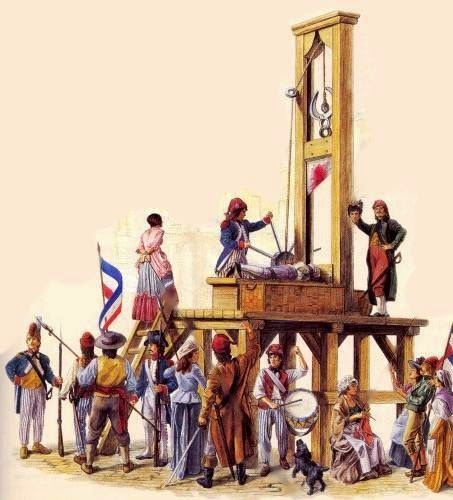
Of course there is much more to this story than can be presented here. To read a much more intense and detailed version of the story, I highly recommend How to Ruin a Queen" Marie Antoinette and the Diamond Necklace Affair by Jonathan Beckman.
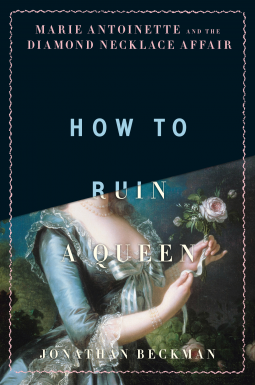
A tale of greed, lust, deceit, theft on an extraordinary scale, charlatanry, kidnapping, assassination and escape from prison. This non-fiction book is an investigation into the people and events that led up to what has been dubbed the diamond necklace affair that helped ignite the French Revolution. This historical scam began to unravel when the jewelers began to demand payment from an unsuspecting Marie Antoinette and her husband, King Louis XVI.
The fraud unravelled when the jewellers began pestering the Queen for payment, and one by one, the culprits were exposed. Cardinal Rohan, a man desperate to rise in power and eager to gain entry into the inner circle of the king and queen. Jeanne, an poor descendant of a king's bastard, Retaux de Villette a fraudster, a prostitute, and an unsuspecting jeweler.
The gullibility of the cardinal, the shrewdness of Jeanne, and the mischief of a prostitute and a brazen lover make this an incredibly interesting read, to say the least. This book is an excellent resource for those who want to learn more about this horrendous scandal, the tumultuous era of the French Revolution, and the sad fate of a king and queen who lost the respect of the public they served.

















